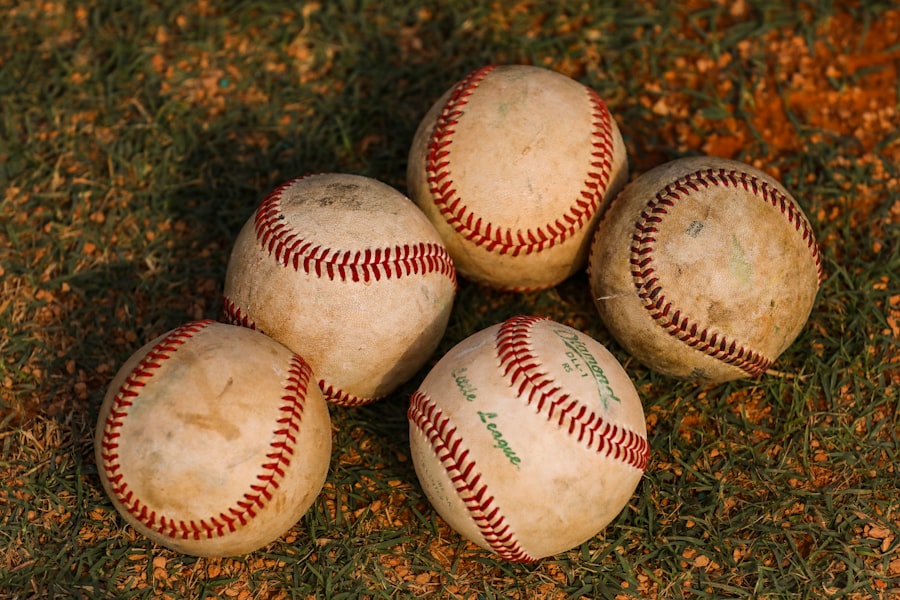Mastering the Art of Softball: Tips for Success
Description
Softball is a bat-and-ball sport that shares many similarities with baseball but has its own unique set of rules and gameplay dynamics. Originating in the late 19th century, softball has evolved into a popular sport played at various levels, from recreational leagues to professional competitions. The game is typically played on a diamond-shaped field, featuring four bases arranged in a square.
The objective is to score runs by hitting the ball and successfully reaching home plate after touching each base in order. The standard dimensions of a softball field differ from those of baseball, with the distance between bases being 60 feet and the pitcher’s mound located 43 feet from home plate in fast-pitch softball. The game is played with a larger ball than that used in baseball, typically measuring 30.5 centimeters in circumference and weighing 180 grams.
Softball can be played in two primary formats: fast-pitch and slow-pitch. Fast-pitch softball emphasizes speed and skill, with pitchers delivering the ball at high velocities, often exceeding 70 miles per hour. In contrast, slow-pitch softball allows for a more leisurely pace, with the ball being pitched in an arc, making it easier for batters to hit.
Understanding these fundamental aspects of the game is crucial for players, coaches, and fans alike, as they form the foundation upon which strategies and techniques are built.
Key Takeaways
- Softball is a team sport played with a larger ball and on a smaller field than baseball.
- Essential skills for success in softball include throwing, catching, hitting, and base running.
- Mastering the fundamentals of hitting involves proper stance, grip, and swing mechanics.
- Perfecting defensive techniques requires agility, quick reflexes, and good communication with teammates.
- Improving pitching and catching abilities involves developing accuracy, speed, and strategic thinking.
Developing Essential Skills for Success
Mastering the Art of Hitting
Hitting involves not only the physical act of swinging a bat but also understanding pitch types, timing, and the mental aspect of anticipating where the ball will be delivered. Players should engage in drills that enhance their hand-eye coordination and bat speed, such as tee work and soft toss exercises.
Developing Defensive Skills
Fielding is another critical skill that demands attention. Players must learn to position themselves correctly, read the ball off the bat, and execute proper catching techniques. Drills that emphasize footwork, glove positioning, and quick reflexes can significantly enhance a player’s defensive capabilities.
Improving Base Running Techniques
Base running is an often-overlooked aspect of the game that can make a substantial difference in scoring opportunities. Players should practice their starts, turns, and slides to become more effective on the bases.
Mastering the Fundamentals of Hitting

Hitting is arguably one of the most critical skills in softball, as it directly impacts a team’s ability to score runs. Mastering the fundamentals of hitting involves understanding stance, grip, swing mechanics, and timing. A proper stance sets the stage for an effective swing; players should adopt a balanced position with their feet shoulder-width apart and knees slightly bent.
The grip on the bat is equally important; players should hold it firmly but not too tightly to allow for fluid movement during the swing. Swing mechanics encompass several key elements: weight transfer, hip rotation, and follow-through. Players should focus on shifting their weight from their back foot to their front foot as they initiate their swing.
This weight transfer generates power and helps drive the ball with greater force. Hip rotation plays a crucial role in generating bat speed; players should practice rotating their hips as they swing to maximize their hitting potential. Finally, a proper follow-through ensures that players maintain balance and control after making contact with the ball. Regular practice of these fundamentals through drills such as live batting practice and situational hitting can significantly enhance a player’s offensive performance.
Perfecting Defensive Techniques
| Defensive Technique | Success Rate | Improvement |
|---|---|---|
| Tackling | 85% | 5% increase from last season |
| Interceptions | 70% | 10% increase from last season |
| Blocking | 90% | 2% decrease from last season |
Defensive play is just as vital as offensive skills in softball, as it can prevent opposing teams from scoring runs. To perfect defensive techniques, players must focus on positioning, footwork, and communication with teammates. Proper positioning allows players to anticipate where the ball will be hit and react accordingly.
Infielders should position themselves closer to the batter when facing a power hitter while outfielders may need to adjust their depth based on the batter’s tendencies. Footwork is essential for effective fielding; players should practice quick lateral movements to get into position for ground balls or line drives. Drills that emphasize agility and speed can help players improve their footwork.
Additionally, communication among teammates is crucial during defensive plays. Players must call for the ball when fielding pop-ups or grounders to avoid collisions and ensure smooth transitions during plays. Developing these defensive techniques through consistent practice will lead to improved team performance and greater success on the field.
Improving Pitching and Catching Abilities
Pitching and catching are two of the most specialized positions in softball, requiring unique skills and a deep understanding of game strategy. For pitchers, mastering various pitch types—such as fastballs, change-ups, curves, and rise balls—is essential for keeping batters off balance. Each pitch type has its own mechanics; for example, a rise ball requires an upward motion during delivery to create an illusion of height before dropping into the strike zone.
Pitchers should also focus on their mental game, learning how to read batters’ tendencies and adjusting their strategy accordingly. Catchers play a pivotal role in supporting pitchers while also managing the defense. They must possess strong receiving skills to handle pitches effectively while framing them to appeal to umpires for strikes.
Additionally, catchers need to develop quick reflexes for blocking pitches in the dirt and throwing out base runners attempting to steal. Communication between pitchers and catchers is vital; they must work together to develop game plans based on opposing hitters’ strengths and weaknesses. Regular practice sessions that include pitch-calling scenarios and situational drills can enhance both pitching and catching abilities.
Enhancing Teamwork and Communication

Building Trust and Camaraderie
Coaches can facilitate team building by organizing activities that encourage players to bond outside of practice sessions. This helps players feel comfortable with one another, leading to open communication during games and improved performance on the field.
Effective Communication on the Field
On-field communication is crucial during gameplay. Players must call out plays, signal for balls, and provide encouragement to one another. Infielders need to communicate about who will field ground balls or pop-ups, while outfielders must coordinate their movements when tracking fly balls.
Clear Signals for Success
Establishing clear signals for plays can also enhance teamwork. Using hand signals or verbal cues can help convey strategies without alerting opponents. By prioritizing teamwork and communication both on and off the field, teams can create a cohesive unit capable of executing complex plays effectively.
Mental Preparation and Focus
The mental aspect of softball is often overlooked but is just as important as physical skills when it comes to performance. Players must develop mental resilience to handle pressure situations during games—whether it’s stepping up to bat with runners in scoring position or making a crucial defensive play in a tight game. Visualization techniques can be beneficial; players should practice imagining themselves succeeding in various scenarios before stepping onto the field.
Focus is another critical component of mental preparation. Players need to learn how to block out distractions—such as crowd noise or opposing players’ antics—to maintain concentration during critical moments of play. Mindfulness exercises can help athletes stay present in the moment rather than dwelling on past mistakes or worrying about future outcomes.
Coaches can incorporate mental training into practice routines by including scenarios that require quick decision-making under pressure.
Training and Conditioning for Peak Performance
To achieve peak performance in softball, athletes must engage in comprehensive training and conditioning programs that address strength, agility, endurance, and flexibility. Strength training is essential for building muscle power necessary for hitting and throwing effectively; exercises such as squats, lunges, and resistance band workouts can help develop lower body strength while upper body workouts focus on arms and shoulders. Agility drills are crucial for improving quickness on the field; ladder drills, cone sprints, and shuttle runs can enhance foot speed and coordination.
Endurance training—such as running or interval workouts—ensures that players maintain energy levels throughout games while flexibility exercises like yoga or dynamic stretching improve range of motion and reduce injury risk. Incorporating sport-specific drills into conditioning routines can further enhance performance; for example, practicing pitching mechanics while fatigued simulates game conditions where players must perform under pressure. By committing to a well-rounded training regimen that includes strength building, agility work, endurance training, and flexibility exercises, softball players can optimize their physical capabilities and elevate their game to new heights.
If you’re looking to improve your softball skills, you may want to check out this article on Flex Cleaner Boost and Speed. This article discusses a product that can help enhance your performance on the field. Whether you’re a pitcher looking to increase your speed or a fielder wanting to improve your agility, this product may be worth considering.
FAQs
What is softball?
Softball is a bat-and-ball sport that is similar to baseball. It is played on a smaller field and with a larger ball.
How is softball played?
Softball is played between two teams of nine players each. The game consists of innings, with each team taking turns to bat and field.
What are the basic rules of softball?
The basic rules of softball include pitching the ball underhand, hitting the ball with a bat, running the bases, and fielding to get the opposing players out.
What equipment is used in softball?
The equipment used in softball includes a bat, a ball, gloves for fielding, helmets for batting, and protective gear for the catcher.
What are the different types of softball?
There are two main types of softball: fastpitch and slowpitch. Fastpitch softball is played with a larger ball and faster pitching, while slowpitch softball is played with a smaller ball and slower pitching.
What are the health benefits of playing softball?
Playing softball can help improve cardiovascular health, strength, agility, and hand-eye coordination. It also promotes teamwork and social interaction.





